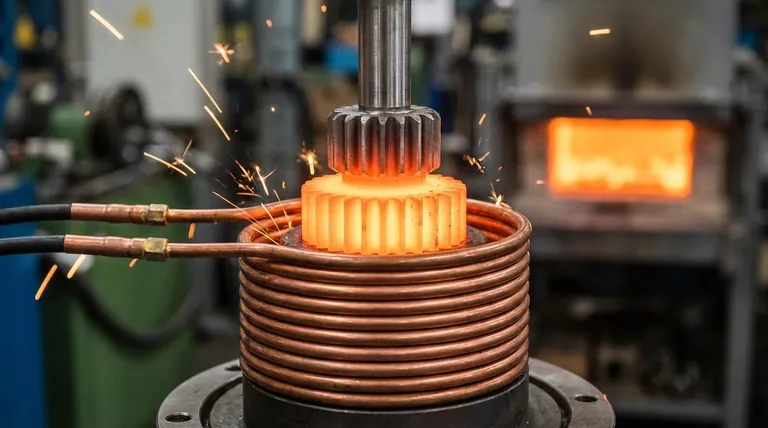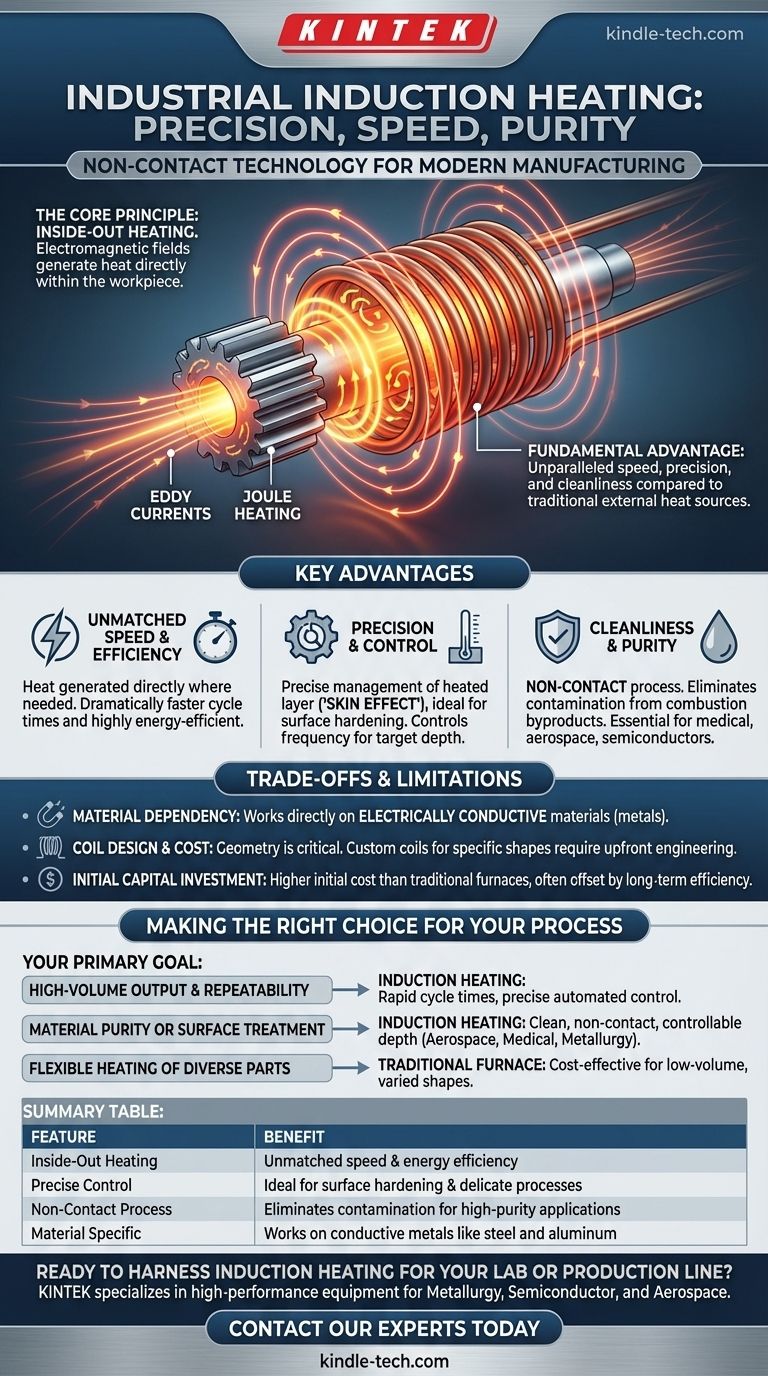At its core, industrial induction heating is a non-contact process that uses electromagnetic fields to rapidly and precisely heat electrically conductive materials from the inside out. Instead of applying an external flame or heating element, it generates heat directly within the workpiece itself, making it a cornerstone technology in processes like metal hardening, brazing, and high-purity crystal growth for semiconductors.
The fundamental advantage of induction heating is its ability to generate heat internally within an object. This bypasses the slow process of external heat transfer, offering unparalleled speed, precision, and cleanliness compared to traditional furnace or flame-based methods.

The Core Principle: Heating from the Inside Out
To understand why induction heating is so effective, you must grasp its unique mechanism, which combines two fundamental physics principles: electromagnetic induction and Joule heating.
The Role of the Induction Coil
The process begins with a high-frequency alternating current (AC) passing through a copper induction coil. This coil, often custom-shaped for the specific part, generates a powerful and rapidly changing magnetic field in the space within and around it.
Generating Eddy Currents
When an electrically conductive workpiece, such as a steel gear or a block of aluminum, is placed inside this magnetic field, the field induces circular electric currents within the metal. These are known as eddy currents, as described by Faraday's Law of Induction.
From Current to Heat
The material of the workpiece has a natural resistance to the flow of these eddy currents. As the currents push against this resistance, they generate intense, localized heat. This effect, known as Joule heating, is the same principle that causes any electrical wire to warm up, but it is highly concentrated in an induction process.
Key Advantages in Industrial Settings
The "inside-out" heating mechanism gives induction several decisive advantages that make it a superior choice for many demanding applications.
Unmatched Speed and Efficiency
Because heat is generated directly where it is needed, the workpiece reaches its target temperature extremely quickly. This dramatically reduces cycle times compared to conventional furnaces, which must slowly heat an object via thermal conduction from the outside. The direct energy transfer also makes the process highly energy-efficient.
Precision and Control
The heating effect is concentrated near the surface of the part, a phenomenon known as the "skin effect." By carefully controlling the frequency of the AC current, engineers can precisely manage the depth of this heated layer. This makes induction ideal for applications like surface hardening, where you need a hard, wear-resistant surface while keeping the core of the component tough and ductile.
Cleanliness and Purity
Induction is a non-contact process. The part never touches a flame or a heating element, eliminating contamination from combustion byproducts or external materials. This absolute cleanliness is essential for manufacturing sensitive products in the medical, aerospace, and semiconductor industries.
Understanding the Trade-offs and Limitations
While powerful, induction heating is not a universal solution. Its effectiveness is dependent on specific conditions and requirements.
Material Dependency
The primary limitation is that induction heating only works directly on electrically conductive materials. Metals are ideal candidates. Materials like ceramics, plastics, or glass cannot be heated directly by induction, though they can sometimes be heated indirectly using a conductive susceptor.
Coil Design and Cost
The induction coil is the heart of the system and its geometry is critical. For maximum efficiency, the coil must be designed to closely match the shape of the workpiece. This can require significant upfront engineering and investment in custom coils, especially for complex parts.
Initial Capital Investment
Induction heating systems, which include a power supply and custom coils, can have a higher initial capital cost than simpler, traditional furnaces. However, this is often offset over time by higher throughput, lower energy consumption, and reduced scrap rates.
Making the Right Choice for Your Process
Selecting the right heating technology depends entirely on your specific industrial goal.
- If your primary focus is high-volume output and repeatability: Induction is an exceptional choice due to its rapid cycle times and precise, automated control.
- If your primary focus is material purity or surface treatment: The clean, non-contact nature and controllable heating depth of induction are unrivaled for applications in aerospace, medical, and high-performance metallurgy.
- If your primary focus is flexible heating of diverse, low-volume parts: A traditional furnace may be more cost-effective if you frequently switch between parts of vastly different shapes and sizes, avoiding the need for multiple custom coils.
Ultimately, induction heating empowers engineers with a fast, clean, and highly controllable tool to solve modern manufacturing challenges.
Summary Table:
| Feature | Benefit |
|---|---|
| Inside-Out Heating | Unmatched speed and energy efficiency |
| Precise Control | Ideal for surface hardening and delicate processes |
| Non-Contact Process | Eliminates contamination for high-purity applications |
| Material Specific | Works directly on electrically conductive metals like steel and aluminum |
Ready to harness the power of induction heating for your lab or production line?
KINTEK specializes in high-performance lab equipment and consumables. Whether you're in metallurgy, semiconductor research, or aerospace manufacturing, our induction heating solutions can enhance your process with superior speed, control, and purity.
Contact our experts today to discuss how we can tailor a solution to your specific industrial needs!
Visual Guide

Related Products
- Silicon Carbide SiC Thermal Heating Elements for Electric Furnace
- 600T Vacuum Induction Hot Press Furnace for Heat Treat and Sintering
- Platinum Sheet Electrode for Laboratory and Industrial Applications
- Double Plate Heating Press Mold for Lab
- Three-dimensional electromagnetic sieving instrument
People Also Ask
- What is SiC elements? The Ultimate High-Temperature Heating Solution
- What is silicon carbide rod heated to high temperature used as? A Premier Heating Element for Extreme Environments
- What is the maximum temperature for silicon carbide heating element? The Real Limit for Your High-Temp Furnace
- What is the maximum temperature for a SiC heating element? Unlock the Key to Longevity and Performance
- What kind of metal is used in heating elements? A Guide to Materials for Every Temperature & Atmosphere



















